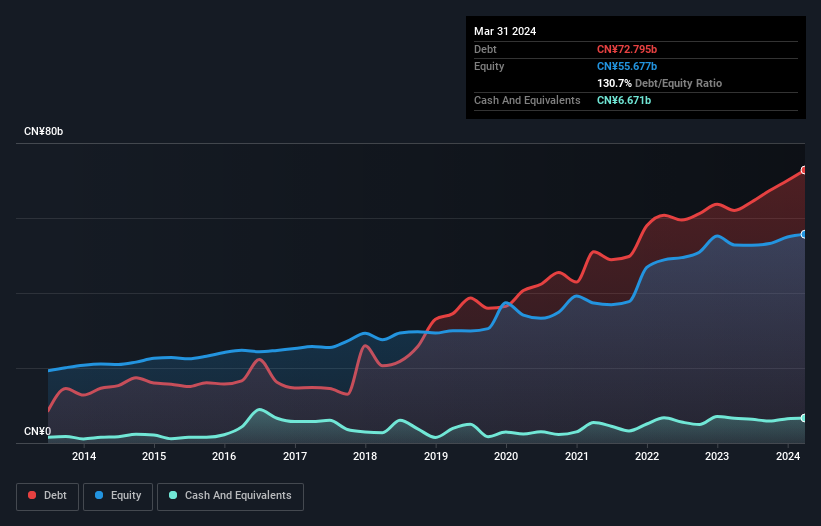- China
- /
- Infrastructure
- /
- SHSE:600350
Shandong Hi-speed (SHSE:600350) Has A Somewhat Strained Balance Sheet

Legendary fund manager Li Lu (who Charlie Munger backed) once said, 'The biggest investment risk is not the volatility of prices, but whether you will suffer a permanent loss of capital.' So it might be obvious that you need to consider debt, when you think about how risky any given stock is, because too much debt can sink a company. We can see that Shandong Hi-speed Company Limited (SHSE:600350) does use debt in its business. But is this debt a concern to shareholders?
Why Does Debt Bring Risk?
Debt and other liabilities become risky for a business when it cannot easily fulfill those obligations, either with free cash flow or by raising capital at an attractive price. In the worst case scenario, a company can go bankrupt if it cannot pay its creditors. However, a more frequent (but still costly) occurrence is where a company must issue shares at bargain-basement prices, permanently diluting shareholders, just to shore up its balance sheet. Of course, the upside of debt is that it often represents cheap capital, especially when it replaces dilution in a company with the ability to reinvest at high rates of return. The first thing to do when considering how much debt a business uses is to look at its cash and debt together.
See our latest analysis for Shandong Hi-speed
How Much Debt Does Shandong Hi-speed Carry?
As you can see below, at the end of March 2024, Shandong Hi-speed had CN¥72.8b of debt, up from CN¥62.0b a year ago. Click the image for more detail. On the flip side, it has CN¥6.67b in cash leading to net debt of about CN¥66.1b.

A Look At Shandong Hi-speed's Liabilities
We can see from the most recent balance sheet that Shandong Hi-speed had liabilities of CN¥32.3b falling due within a year, and liabilities of CN¥65.5b due beyond that. On the other hand, it had cash of CN¥6.67b and CN¥11.4b worth of receivables due within a year. So it has liabilities totalling CN¥79.6b more than its cash and near-term receivables, combined.
This deficit casts a shadow over the CN¥42.8b company, like a colossus towering over mere mortals. So we'd watch its balance sheet closely, without a doubt. After all, Shandong Hi-speed would likely require a major re-capitalisation if it had to pay its creditors today.
In order to size up a company's debt relative to its earnings, we calculate its net debt divided by its earnings before interest, tax, depreciation, and amortization (EBITDA) and its earnings before interest and tax (EBIT) divided by its interest expense (its interest cover). This way, we consider both the absolute quantum of the debt, as well as the interest rates paid on it.
As it happens Shandong Hi-speed has a fairly concerning net debt to EBITDA ratio of 6.8 but very strong interest coverage of 12.9. This means that unless the company has access to very cheap debt, that interest expense will likely grow in the future. Importantly Shandong Hi-speed's EBIT was essentially flat over the last twelve months. We would prefer to see some earnings growth, because that always helps diminish debt. The balance sheet is clearly the area to focus on when you are analysing debt. But ultimately the future profitability of the business will decide if Shandong Hi-speed can strengthen its balance sheet over time. So if you want to see what the professionals think, you might find this free report on analyst profit forecasts to be interesting.
But our final consideration is also important, because a company cannot pay debt with paper profits; it needs cold hard cash. So we clearly need to look at whether that EBIT is leading to corresponding free cash flow. Considering the last three years, Shandong Hi-speed actually recorded a cash outflow, overall. Debt is usually more expensive, and almost always more risky in the hands of a company with negative free cash flow. Shareholders ought to hope for an improvement.
Our View
To be frank both Shandong Hi-speed's net debt to EBITDA and its track record of staying on top of its total liabilities make us rather uncomfortable with its debt levels. But on the bright side, its interest cover is a good sign, and makes us more optimistic. It's also worth noting that Shandong Hi-speed is in the Infrastructure industry, which is often considered to be quite defensive. We're quite clear that we consider Shandong Hi-speed to be really rather risky, as a result of its balance sheet health. So we're almost as wary of this stock as a hungry kitten is about falling into its owner's fish pond: once bitten, twice shy, as they say. There's no doubt that we learn most about debt from the balance sheet. But ultimately, every company can contain risks that exist outside of the balance sheet. Case in point: We've spotted 2 warning signs for Shandong Hi-speed you should be aware of, and 1 of them is a bit unpleasant.
At the end of the day, it's often better to focus on companies that are free from net debt. You can access our special list of such companies (all with a track record of profit growth). It's free.
If you're looking to trade Shandong Hi-speed, open an account with the lowest-cost platform trusted by professionals, Interactive Brokers.
With clients in over 200 countries and territories, and access to 160 markets, IBKR lets you trade stocks, options, futures, forex, bonds and funds from a single integrated account.
Enjoy no hidden fees, no account minimums, and FX conversion rates as low as 0.03%, far better than what most brokers offer.
Sponsored ContentNew: Manage All Your Stock Portfolios in One Place
We've created the ultimate portfolio companion for stock investors, and it's free.
• Connect an unlimited number of Portfolios and see your total in one currency
• Be alerted to new Warning Signs or Risks via email or mobile
• Track the Fair Value of your stocks
Have feedback on this article? Concerned about the content? Get in touch with us directly. Alternatively, email editorial-team (at) simplywallst.com.
This article by Simply Wall St is general in nature. We provide commentary based on historical data and analyst forecasts only using an unbiased methodology and our articles are not intended to be financial advice. It does not constitute a recommendation to buy or sell any stock, and does not take account of your objectives, or your financial situation. We aim to bring you long-term focused analysis driven by fundamental data. Note that our analysis may not factor in the latest price-sensitive company announcements or qualitative material. Simply Wall St has no position in any stocks mentioned.
About SHSE:600350
Shandong Hi-speed
Engages in the investment, operation, and management of toll roads, bridges, and tunnel infrastructure; and related businesses in China.
Established dividend payer and slightly overvalued.
Market Insights
Community Narratives



